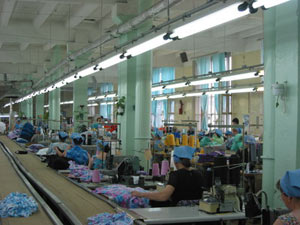Home page
» ECONOMY
» Agrarian industry
» Light industry
Light industry Light industry consists of weaving, sewing, fur-leather, skin-leather, shoe, knitting, and carpet-making fields. In 1913, 300 tons of raw silk, 22000 t raw cotton without seeds, 4 million tons wool was produced in Azerbaijan, which comprised respectively 79%, 10%, and 2% of the total production in Russia. Despite of the large labor resources, Azerbaijan was considered a great raw material exporting country. The Russian factory owners, were afraid of losing the cheap raw material resources, deliberately delayed factory-plant weaving, industrial production of sewing, knitting products, and shoes. Like the other remote regions of the tsar Russia, Azerbaijan was also hardly kept in the indicator role of all types of products manufactured in the center. Until the World War II, several large enterprises were built in the country: Cloth factory in Gandja, several cotton refineries (Yevlakh, Gandja, Ucar, Salyan, Berde), Silk plants in Sheki and Khankendi, sock-knitting factory in Baku, two sewing, and own shoe factory were put into operation. Several large enterprises were built after the war: textile plant in Mingechevir, pile yarn, knitting, and sewing factories in Sumgait, carpet plant and sewing factory in Gandja, shoe, sewing, skin factories in Baku, cocoon-making factory in Ordubad, knitting, sewing, and carpet factories in Nakhchivan, and sewing factories in other cities. Light industry is closely connected with the chemical industry, which provides it with the plant raw materials (cotton, flax), animal raw materials (wool, silk, fur-leather), and artificial and synthetic fiber. Artificial fibers are the chemical fibers produced from wood (viscose, acetate, etc); synthetic fibers are prepared from oil, gas, and coal (Capron, lovsan, etc). Light industry has developed in all countries. Since the second of the XX century, the share of developing countries, which possess rich raw materials and cheap labor forces, has increased in this field in comparison with the developed countries (mainly in the production of cotton cloth). 1.Raw material – passes from the initial processing in the cotton refineries, flax-processing, and wool-washing enterprises. Because of the great wastes, these enterprises are built close to the raw material resources. 2.Spinning – yarn is produced from the fiber at this stage. 3.Weaving – rough material is prepared from the yarn. 90% of the demand to the light industrial products is met through import in Azerbaijan. Light industrial products, especially clothes are bought to Azerbaijan from abroad – Turkey, Iran, Chine, and several European countries.
|
